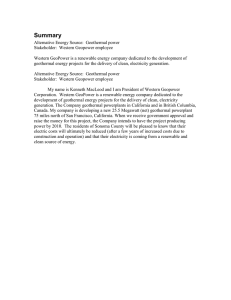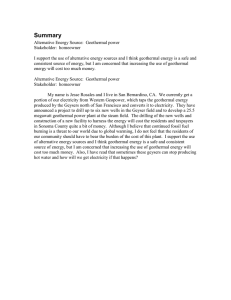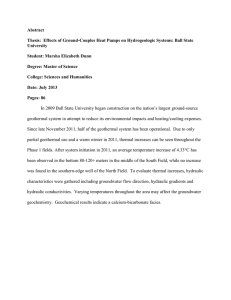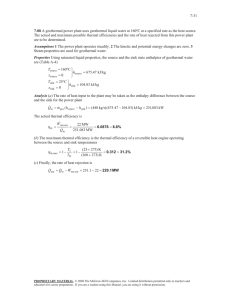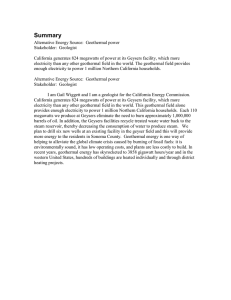Rural/Urban Energy Farms: Onsite Alternative Energy Production
advertisement
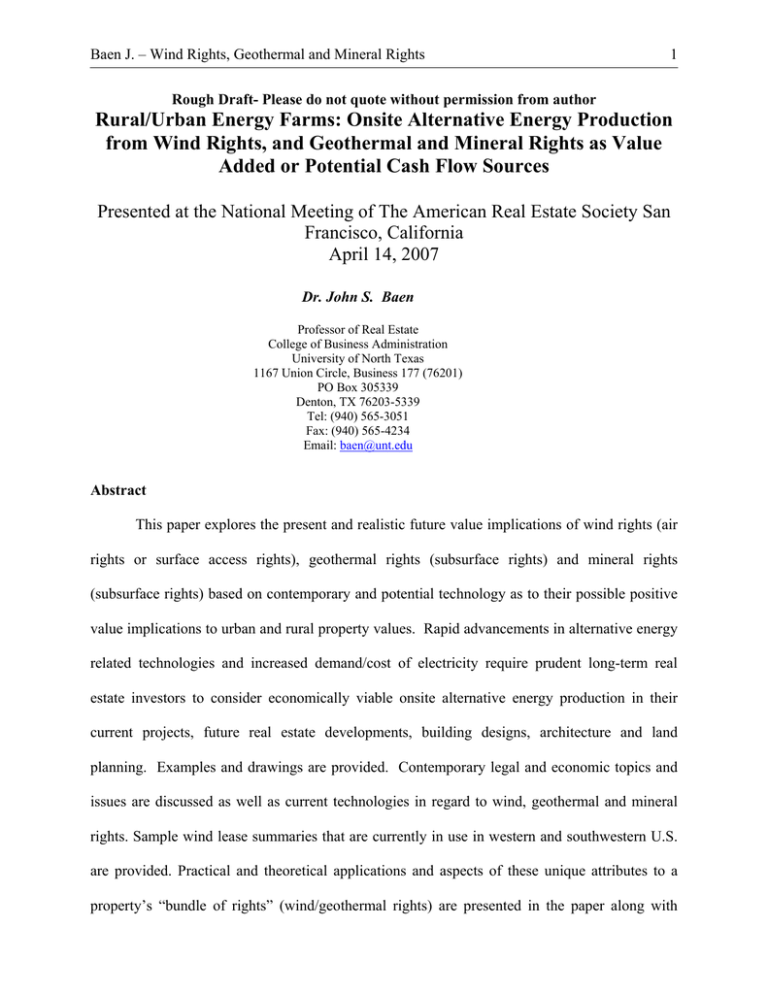
Baen J. – Wind Rights, Geothermal and Mineral Rights 1 Rough Draft- Please do not quote without permission from author Rural/Urban Energy Farms: Onsite Alternative Energy Production from Wind Rights, and Geothermal and Mineral Rights as Value Added or Potential Cash Flow Sources Presented at the National Meeting of The American Real Estate Society San Francisco, California April 14, 2007 Dr. John S. Baen Professor of Real Estate College of Business Administration University of North Texas 1167 Union Circle, Business 177 (76201) PO Box 305339 Denton, TX 76203-5339 Tel: (940) 565-3051 Fax: (940) 565-4234 Email: baen@unt.edu Abstract This paper explores the present and realistic future value implications of wind rights (air rights or surface access rights), geothermal rights (subsurface rights) and mineral rights (subsurface rights) based on contemporary and potential technology as to their possible positive value implications to urban and rural property values. Rapid advancements in alternative energy related technologies and increased demand/cost of electricity require prudent long-term real estate investors to consider economically viable onsite alternative energy production in their current projects, future real estate developments, building designs, architecture and land planning. Examples and drawings are provided. Contemporary legal and economic topics and issues are discussed as well as current technologies in regard to wind, geothermal and mineral rights. Sample wind lease summaries that are currently in use in western and southwestern U.S. are provided. Practical and theoretical applications and aspects of these unique attributes to a property’s “bundle of rights” (wind/geothermal rights) are presented in the paper along with Baen J. – Wind Rights, Geothermal and Mineral Rights 2 development of urban energy farms as a part of the urban landscape and skyline. The concept of a dynamic urban skyline is presented in several figures and diagrams. Key words: Alternative Energy, Wind Farms, Urban Energy Farms, Wind Rights, Oil and Gas Rights, Geothermal Rights, Mineral Rights, and Residual Oil and Gas Well Rights. Baen J. – Wind Rights, Geothermal and Mineral Rights 3 Introduction Energy economics, return on investments and affordable energy production will drive both innovation and implementation of alternative energy sources in terms of locational factors, building designs, and innovative land use, which is more than a quest for “green building” projects or noble ideas for reducing global warming. Real Estate owners can add long-term value/ cash flow potential for their existing and new projects by considering the very real applications offered in this paper. There are commercially successful examples of each alternative form of energy creation currently in operation today. Recent rapid improvements in alternative energy production technology (wind speeds of 9 mph are viable) when combined with and increasing prices of electricity have caused a surge in energy deals, IPOs and targets by financial markets and investors. Figure 1. Conceptual Use of 4 acres as an Urban Energy Farm for the Multiple Use of Energy Production from Wind, Oil and Gas, and Geothermal as well as other Uses of the Surface. Commercially, alternative energy production costs have dropped to the following levels without considering tax credits or other incentives (WSJ 2007) making royalties or direct investment prospects viable for property owners. Wind 6-9¢ / Kilowatt Hr Geothermal 6-10¢ / Kilowatt Hr Natural Gas 3.4-7¢ / Kilowatt Hr Coal 3.11-3.4¢ / Kilowatt Hr Baen J. – Wind Rights, Geothermal and Mineral Rights 4 The difference in wind and geothermal energy production is that there are not costs of “feed stocks” after equipment and installation investments are recovered by the producer as these are from renewable or “perpetual” energy sources… wind and the earth’s heat. The central hypothesis of this research is to establish that well planned urban energy farms will create an economically viable and environmentally friendly, dynamic skyline of wind turbines, urban oil and gas wells and geothermal energy production which will become an accepted and important part of modern cities. Many real world applications are economically functioning today. Real estate owners can add value or cash flow to their urban real estate investments by considering development of on-site urban energy farms and can benefit through royalties or direct investment in alternative energy sources of wind, geothermal and oil and gas in excess land, parking lots, and/or existing structures. Figure 2. Conceptual Designs and Potential Engineering of Urban Elevated Structures for Energy Cash Flow Generation. (JS Baen, etc.) Urban land, tall buildings and existing structures could be redesigned (Figure land 2) and/or retrofitted to accommodate new important sources of benefits to property owners and will have no more negative impacts or perception than the noises associated with other essential components of urban environments: - Airports - Trains - Freeways/ traffic - Power plants Baen J. – Wind Rights, Geothermal and Mineral Rights - HVAC plants/systems - Factories/ industrial uses 5 Water producing windmills, radio and cell phone towers, and high voltage power line towers have become common place in rural and urban areas. So too have large commercial electric generating wind farms in Texas, California, and other states. In Texas alone there are 37,000 miles of high voltage power lines (ERCOT 2007) having 565,000 tall transmission towers. Rural wind generation of electricity and other alternative forms of energy are greatly limited by location relative to economic wind, electric, grid, and grid capacities, which are not generally limitations in urban areas, where most electricity/ energy is utilized and where the electric “grids” merge for consumption. Currently there are many metropolitan areas which have ongoing urban drilling for oil and gas occurring on 2-5 acre tracts of land in high density areas (Dallas, Fort Worth, Los Angeles, Houston, etc) Alternative energy production and cash flow to property owners can synergistically occur on these sites or elsewhere in urban areas with other land uses co-existing with energy production. Figure 1 indicates parking, however, there are many other uses (industrial storage, open space, etc). Baen J. – Wind Rights, Geothermal and Mineral Rights 6 What is Driving the Trend in Alternative Energy? “Clean,” “green,” “renewable,” “non-global warming” and “environmentally friendly” are terms which are frequently used in the popular press and television news reports. The news generally describes new alternative sources of energy as only being located in remote rural locations. While many of these “eco-friendly” factors are the motivation for a small portion of the initiators and individuals who build personal home wind and solar systems, the stark realties are that sound economics and technology are improving to the point that what once was a novelty, is now a commercially economic business reality for the following reasons: 1) The worldwide costs and demand for electricity is rising due to significant increases in the prices of coal, oil and natural gas. Figure 3. 2) Increasing income streams offered to property owners have become very attractive to those who host sites, either as direct investors in equipment/systems or as lessors/landowners/ royalty owners earning a percentage of gross income without risk or expense. Wind royalties currently range from 6-10 %. Oil and gas royalties range from 12.5 % to 28% of gross revenues generated. There are no references in regard to royalties being paid to private or landowners for geothermal energy production; although, there are several commercial/industrial applications of geothermal energy production that are economical in the western U.S. (see attached wind lease summary, signing bonuses, construction fees and damages from Shell Oil) Figure 9. 3) There has been accelerated research and funding for improved technology by major companies (Shell Oil, BP, General Electric, Mitsubishi, governments, U.S. Department of Energy, Sandia Labs, Small Business Administration) and universities (MIT, Texas A&M, University of Denver, etc.). Baen J. – Wind Rights, Geothermal and Mineral Rights 7 4) The lower interest rate environment of 2004-2007, and therefore lower capitalization rates required by investors, have made returns on alternative energy investments more competitive with other investments and have approached financial returns from investments in stocks, bonds, CD’s etc. 5) Federal and state tax incentives have been implemented in the form of tax credits, rapid equipment deprecation, cost of drilling “write-offs”(oil and gas/ geothermal wells) and, in particular, tax credits on energy or excess energy produced by any individual or company producing on-site energy/ electricity using “alternative methods of energy production.” 6) The economic realities of a national market for any electricity generated anywhere in the U.S. due to federal deregulation, mandated power incentives to producers and the assured market price availability for any power produced (reference: NJCEP.com/srec/tradingstatistics.html, Alsever 2007) 7) There appears to be some public “value” or corporate “image building” associated with alternative “green” energy being used or purchased by generators and users. 8) Third world countries and remote towns/ cities having no electricity, are not as concerned about the effective cost of the energy produced or the equipment investment requirement but more with availability of electricity for living! India, Africa, South America and remote homes/ ranches in the U.S. have greatly contributed to both numbers of users as well as innovations in technology and applications in the production of alternative energy. 9) Equipment loans and grants for building or producing alternative energy systems are available. The U.S. government announced on 3-30-07 the availability of $176.5 million in USDA loan guarantees and $11.4 million in competitive grants for equipment purchases for use in alternative/renewable energy systems utilizing wind, solar, biomass, Baen J. – Wind Rights, Geothermal and Mineral Rights 8 geothermal or hydrogen sources. Loan guarantees cover up to 50% of a project’s cost not to exceed $10 million and equipment grants that range from $250-500 thousand dollars are available. (http://rurdev.usda.gov/tx/# or Jack County Herald 3-30-07 p 2A) 10) Real domestic and geopolitical risks of oil and gas supply interruption and the reality of recent “rolling blackouts” in California (2005) and New York (2004) have occurred due to peak demand and shortages, along with the failures of “backup systems” on the U.S. National Grid and have increased interest in alternative energy production. 11) For individuals and companies that both produce and consume their own electricity on site (individual homes, etc.) there is an element of “free” nontaxable effective income or benefits that are combined with tax credits for the purchase of equipment or sale of excess energy produced (which is taxable but highly sheltered). Baen J. – Wind Rights, Geothermal and Mineral Rights 9 Literature Review-Valuation of Alternative Energy as “Other Income” for Property Owners Very little has been published in regard to income or value impacts of alternative “exotic” energy and income sources that are the topic of this research, which can be best described as “other income.” In fact, many oil and gas and wind contract terms are confidential. Many wind, oil and gas contracts, leases or long term agreements are confidential while with only memoranda are filed for public record (Figure 10). Data and confirmation of terms are treated as “commercial secrets” which create problems for investment analysis and contributes greatly to a general lack of publications while maintaining a very inefficient market for these rights. However, the appraisal literature does consider the definition and often professional approaches to analyzing “other” income as a secondary source of revenue which are typically “generated as additional income to any real property’s primary revenue source, space rental or use.” They caution that other income is not uniformly or authoritively presented in appraisal reports but quite often has a major impact on value or positive cash flows. Anglyn et. a (1992) considers more traditional “other” income sources such as late fees, vending machines, forfeited deposits, application fees, etc. It should be noted that on-site use of generated electricity or other benefits of alternative income streams presented in this paper do not generally reduce rents to tenants as many leases in both the urban and rural real estate markets are “triple net” (tenants pay all expenses, utilities taxes, insurance and maintenance) but increases a property’s Net Operating Income (NOI). Therefore, the benefit stream from alternative energy should directly benefit the property owner, whether the additional income stream is from royalties, from outright sale of commodities(electricity, natural gas, or thermal heat) from cost savings from wind generated electricity, geothermal energy (electric or more efficient HVAC Systems) or oil and gas (royalty, use or sale). Baen J. – Wind Rights, Geothermal and Mineral Rights 10 Any income stream, service, utility or cost savings from wind rights, geothermal rights, or oil and gas rights that contributes to a higher present value, lower operating costs or higher resale price should be considered positive so long as any negative impacts to the subject property are not greater than the benefits gained. In measuring the positive or “value added” components of the topic of this paper, the measurable and verifiable negative impact, if any, should also be considered in any conclusion of a property’s appropriate primary highest and best use, in order to compare the cost benefit analysis of any additional income stream or cost savings, to determine whether or not the opportunity or potential benefits are worth the additional capital cost, to identify loss of any significant land value or other negative impacts to the primary income stream or value components of the subject land/ property. The positive cash flow or value added implications of alternative energy income streams can be measured through the three traditional appraisal approaches if data is available. It is much easier to value pure royalty income if a third party energy company pays all the initial capital/equipment costs and shares the gross income stream through some form of revenue sharing, royalty, long term lease (surface site) etc. The difficulty in valuing the present value of energy produced is due to the volatility of energy prices as indicated in Figure 3 “A Brief History of Pricing Power” (Smith 2007). A discounted cash flow approach of the initial oil and gas bonuses paid and future verifiable income streams were presented by Baen (1988 and 1998) in regard to mineral rights and royalty rights in land appraisals. It seems appropriate that the same approaches and assumptions to value should be used to value wind and geothermal generated electricity rights/benefits or similar income streams with one important exception. The exception would be that while energy prices change over time with a great deal of volatility, oil and gas income streams to property owners generally fall due to the commodity being a depleting asset, according to generally predictable Baen J. – Wind Rights, Geothermal and Mineral Rights 11 decline curves of individual well characteristic and performance. Wind and geothermal energy production/benefits are generally “renewable” energy streams limited only by predictable equipment costs, repairs and depreciation born by the operator. Rapid improvements in energy production technologies and noise reduction have made the topic of this paper timely, quite economical and both practically and economically feasible (i.e. wind generation capabilities have dropped from 23-40 mph required to 8 mph). The national public market exchanges for electricity, oil and gas offer a fairly good foundation for establishing a present value (PV) of these property generated energy related “other” income streams. Baen J. – Wind Rights, Geothermal and Mineral Rights 12 Wind Energy Potential According to the on-line Illustrated History of Wind Power, the first use of a large windmill to generate electricity was a system build in the urban setting of Cleveland, Ohio in 1888 by Charles Bush (http://www.culturechange.org/wind_energy.htm). Windmills to produce water were a major advancement which allowed the expansion and settlement of much of the western U.S. since 1870, because otherwise there would not have been water for households, watering cattle or crops. The rapid international expansion and increase of commercially viable wind turbines for generating electricity is impressive (Figure 6) and is due to important advancements in technology and innovations worldwide. Many parts of the U.S. have more than adequate commercial energy resource potential as indicated in Figure 7 (Wind energy map of U.S.). There are currently over 2700 commercial wind turbines in Texas and over 37,500 miles of high voltage transmission lines that form the “Texas Grid.” Most of the commercial wind farms are in West Texas due to both hilly topography and availability of both transmission lines and capacity to carry produced power. A typical rural or urban home requiring 10 kilowatts of power will need a system that costs $25,000-35,000 and has a 100 foot mast topped with a 25 foot diameter blade assemblage (http://www.culturechange.org/wind_energy.htm) to produce the needed electricity of 10-18 kilowatts. The “payback” period is dependent on wind speeds but estimates are 5-10 years at variable locations. Commercial wind generators are 400 feet in height and cost $1.9 million per installation. Most property owners provide “pad-sites” and are paid a royalty of total electricity produced. Royalties of $250 per month ($3,000/year) are not uncommon and minimized payments are often Baen J. – Wind Rights, Geothermal and Mineral Rights 13 granted to be less than $10,000 per (see Figures 9& 10 Shell Oil Offering Memorandum). Royalties vary due to the following factors: 1) Amount of wind (variable) 2) Height of wind turbine 3) % royalty negotiated (variable) 4) Price of power produced/ sold (variable) Assume royalties of $30,000 were paid to an urban commercial shopping center, office building or urban land owner. At prevailing capitalization rates of “6%,” the present value (PV) or added value is $500,000 per wind turbine ($30,000/year NOI ÷ .06 CAP =$500,000). Wind rights can be retained on a sale of property and assuming good manufacturing of the equipment is a perpetual royalty and with the high likelihood of a built in inflation protection factor and great likelihood of additional generation and therefore value enhancement to the real estate as technology improves. There are some differences of opinion about wind turbines as a part of the rural and urban landscapes. Many find them fascinating and others call them “visual pollution.” There are many highly visual urban structures that have become part of the sites of cities. Figure 11. It is possible that many of these or future structures could also host wind turbines. According to recently published studies on noise, wind turbines have little to no impact on noise levels beyond 12000-1500 feet (Sterzinger 2003). Others have indicated noise equivalent to be less than air conditioning noise in the urban environment (Figure 12). Noise maps (Figure 13) are subject to prevailing wind, the type of turbines and other factors. Advances in blade and motor designs offer great promise in further reducing noise. The San Francisco Chronicle is an April 13, 2007 article stated that a cylindrical wind turbine and solar panel combination will power 60% of the total eclectic requirement for a new government building. Baen J. – Wind Rights, Geothermal and Mineral Rights 14 Urban Oil and Gas Energy Potential Urban drilling has been a reality in Los Angeles Texas; and Long Beach, California and Houston, Texas for over fifty years (Baen, 1998). In the last four years, there have been over 5700 deep gas wells (8,000-9,000 feet) drilled in the Dallas/ Fort Worth metropolitan area. The Barnet Shale tight gas blanket shale formation is located directly under the Central Business District of Fort Worth, Texas, and extends into the five surrounding suburban continues and has become the largest gas field is the U.S. Similar shales exists and are being drilled through the U.S. (Pennsylvania, New York, etc). Figure 15. Very few commercial property owners have invested directly in the development of these wells, which cost between $1-3 million each. However, these few investors enjoy highly significant royalty income streams which are expected to last 15-20 years. The vertical well bores extend down 8000-9000 feet and then extend horizontally 30005000 feet from the urban/ suburban 2-4 acre drilling/ production sites. Commercial and industrial surface owners have found that the cost benefit analysis of a “temporary” loss of land is much less than the present value of lease agreement signing bonus money, overriding royalty, damage monies and royalties received over a number of years (Baen 2004, 2005). The exciting prospect of eventually converting the ultimately depleting gas wells to geothermal wells will be discussed elsewhere in the paper. At least one 4.2 acre “temporary” urban drill-site has a surface use agreement with an oil company to drill six (6) individual gas wells on the site which will yield million of dollars to the surface estate owner as follows: 1) A $75,000 signing bonus at t0 2) $50,000 in “damages” per well bore ($50K x 6 = $300,000/ tax deferred, reduces basis) Baen J. – Wind Rights, Geothermal and Mineral Rights 15 3) 25% royalty income stream of gas produced from mineral rights owned 15-20 years 4) A 3% overriding royalty interest for well accommodations /site use) on 100% of all gross income sold from all wells over an extended period of time 15-25 years. The host surface site owner participates in wells drilled into mineral rights not owned and can equate to $300 per day per well, initial payment. After drilling and completion, the site and all equipment shrink to a 1-acre production site which will yield millions of dollars to the urban surface owners over time. There are over 5000 of these sites existing in the DFW area as of April 2007 and lend themselves as perfect Urban energy farms sites in the future. These sites are fenced, graveled, kept neat and clean and could easily host other non-conflict uses such as the following: 1) Wind turbines 2) Geothermal wells by conversion of depleted gas wells (185o degree temperature at 9000 ft.) 3) Gas operated electrical generating plants 4) Urban water wells and water towers needed for geothermal or public water supply. The application of generating energy from both oil and gas and geothermal wells (depleted oil and gas well conversions rather than plugging them) is a tremendous opportunity in both Texas and many other regions in the U.S. Figure 1. North Texas 2006 drilling permit map 1st 9 months of 2006. Figure 16. Texas 2006 drilling permit map 1st 9 months of 2006. Figure 21. Current Wells and Drilling (4-10-07). Baen J. – Wind Rights, Geothermal and Mineral Rights 16 The realistic potential of geothermal energy researched and reported by the MIT/ Dept. of Energy Study (2007) was limited particularly by the initial cost drilling of wells below 5000 feet. The potential of depleted oil and gas well conversions to geothermal energy production overcomes this economic factor and turns a cost center (plugging the wells and abandoning the sites) into a profit center (conversion to geothermal energy production) and continues energy production from a previously disrupted site. Oil and gas leases are generally silent in regard to the geothermal heat; therefore, land owners will need to consider new agreements as the oil companies own the well bore and well casing. It is assumed that geothermal heat is not a mineral and belongs to the surface estate owner as part of the “Bundle of Rights” theory. Baen J. – Wind Rights, Geothermal and Mineral Rights 17 Urban Geothermal Energy Potential A joint MIT and U.S. Department of Energy study (2007) has concluded that mining huge amounts of heat “that reside as stored thermal energy in the Earth’s hard rock crust could supply a substantial portion of the electricity the United Sates will need in the future, probably at competitive prices and with minimum environmental impact.” Figure 18. Map of Geothermal Potential in the U.S. Figure 15. Gas Shale Map of Current Well Drilling Areas The conclusion of the study is that the high cost of drilling below 5000 feet is a serious limitation; however, there are many commercially operating economic projects located in California, Hawaii, Utah and Nevada, and electricity output exceeds the total amount currently generated by wind and solar (Toksöz 2007). On-site, the property owner’s geothermal energy generating or savings systems do not always generate electricity or royalties but can theoretically contribute to cost savings in the form of “heat pump” HVAC subsurface water circulating systems that capitalize on the heat exchange differentials between surface temperatures and subsurface temperatures (6-8 feet deep is economical in residential application). The greater the temperature difference, the greater the benefits. Different geothermal designs and construction options are presented by Northcott (2004) which include but are not limited to: 1) Closed horizontal (buried pipe 6-8 feet deep) 2) Closed vertical (deep wells) 3) Closed body of water (under ponds and lakes) Baen J. – Wind Rights, Geothermal and Mineral Rights 18 4) Open well systems (pumping subsurface water for HVAC energy conversion, etc. and discharge at the surface) The Dallas/ Fort Worth metropolitan area has had an oil and gas drilling boom since 2002 which has resulted in over 5700 deep gas wells being drilled in urban and suburban areas at depths below 7000 feet, with thousands of deep wells were permitted in the first 270 days of 2006 (Figure 17 North Texas Oil and Gas Permits and Figure 16 Texas Well Permit.) These 2-4 acre urban and rural drill-sites (Baen 2005) are already generally dedicated to energy production and yield property owners valuable royalties and other benefits. As these oil and gas wells deplete or become uneconomical, they should be converted to geothermal energy production or cost savings assets to property owners (See Note.) Many urban oil and gas areas exist in the U.S. with depleting wells (Houston, LA, etc.) with many new areas of gas being planned and drilled near urban centers in New York State, etc. (see Figure 15). Note: There are several legal questions as to who owns the potential benefit stream. The surface owner owns the “thermal rights” however the oil and gas company owns the well bore and pipe. Most oil and gas leases do not grant the oil company the rights or benefits of geothermal energy. New agreements will need to be created. Baen J. – Wind Rights, Geothermal and Mineral Rights 19 Individual Real Estate Investor/Owners’ Decision/ Option to Generate Alternative Energy On-site The generation of energy to create cash flow in the form of royalties or lower utility costs from an on-site urban or rural energy farm can be achieved through two (2) basic approaches utilizing available land or buildings. The first option for a property owner is to create a royalty or royalty “in kind” benefit stream by negotiating a long term on-site location lease or contract with an energy company who invests and pays for all equipments, construction, costs, maintenance and overhead which yield to the property owner/ rights owner, either: 1) Cash flowing royalty or ground lease income attributable to the dedicated site location or subsurface access to rights (geothermal, oil and gas). Wind “leases” are generally for a fixed term of 20-30 years with options to renew and royalties of 4-9%. Many wind and oil and gas lease terms have confidentiality clauses embedded that make comparative analysis of terms impossible because only memoranda of leases are filed of record that acknowledge the existence of a long term contract. Oil and gas and geothermal leases are generally perpetual with royalties that range from 12.5%-25% for as long as operations are “economic” (Baen). 2) Receiving “Royalty In Kind” in a “take or pay option” offer of a percentage of useable energy produced: - electricity from wind or geothermal production - geothermal produced heat exchange processes that reduce heating air conditioning, or ventilation (HVAC) costs in office buildings, shopping centers, etc. - natural gas from oil and gas leases used on-site to generate electricity for HVAC (University of North Texas Lease 2002/Wells drilled on campus). Baen J. – Wind Rights, Geothermal and Mineral Rights 20 3) Receiving “Royalty In Kind” and selling the commodity (electricity, heat, oil or gas) in in public markets nationwide using public utility distribution systems (electric line or pipelines) under new federal deregulations mandates (electricity and natural gas interstate distribution and national markets at http://njcep.com/srec/trading-statistics.html (Alsever New York Times 3-1-07 p5) The second option is for urban and rural property owners to dedicate a portion of their land or building roof tops to energy production and make the direct capital investments in the equipment and an energy producer for a parallel or additional income stream from the property. The high cost of equipment, changing technology, commodity price volatility, financial risk, and difficulty in financing the initial costs, make this option unlikely and beyond the scope of this paper. There are, however, many examples of individuals and companies that have recently invested in direct energy production as an associated real estate cash flow or cost reduction activity. Examples: 1) The 18,000 acre Alliance multiuse industrial and commercial real estate development in North Fort Worth, Texas (Hillwood/ Perot 2007) has recently started a subsidiary/ associated energy company to drill and produce deep natural gas within the mixed use commercial land development project together with ownership of a gas sale and distribution pipeline system. Comprehensive planning for well-sites in conjunction with industrial and retail sites has recently resulted in over 30 successful wells drilled and no fewer that four (4) drilling rigs currently operating (4-8-2007). The international competitive advantage of having abundant and reliable on-site natural Baen J. – Wind Rights, Geothermal and Mineral Rights 21 gas, electricity and potential geothermal energy production options from future depleted gas wells is a huge incentive for multinational industrial firms to locate in the development. 2) Homeowners investing in economic electric wind generators that cost $12,000 $50,000 and operate economically as low as 9 mph wind, may expect “payback” within 3-5 years after factoring in tax credits, energy credits or selling excess electric @ NJCEP.comsrec/trading-statistics.html (Alsever 2007) Baen J. – Wind Rights, Geothermal and Mineral Rights 22 Conclusion Fee simple real estate ownership is a long term investment with ever expanding components of the “Bundle of Rights” theory that can be reserved, deeded away, leased or developed. Figure 19. Bundle of Rights Figure 20. Contemporary Economic Micro-Component of the Bundle of Rights While ownership and transferability may vary by state laws, new areas of law and questions surround the rights to wind and geothermal heat. Someone once said, “Who can own the wind?” Well, theoretically, one property owner could put up so many turbines that no wind would ever reach a neighboring property. So, is wind a public or private right? Owned by the property while only over his/her land by “rule of capture?” Geothermal rights have similar questions of new law. Property owners should investigate the very real and future cash flow potential that could be realized through rapidly improving technologies and increasing energy prices. Any increase in income derived from alternative energy development creates a positive value impact for property owners. Real estate investors, planners, engineers and developers should consider short and long-term opportunities for alternative energy sites and structures in their urban and rural development projects. Contingency long term planning which project for “what ifs” could yield big dividends in creating energy on-site with existing and future technology. Baen J. – Wind Rights, Geothermal and Mineral Rights 23 References Anglyn et. al Analyzing “Other” Income. Anglyn, WT, Edmonds, CP and Haad, JH. The Appraisal Journal. April 1992. pp. 257-266. Baen, J.S., “Cost/ Benefit Analysis and Ad Valoreum Tax Benefits of Oil and Gas Drilling in the DFW Barnett Shale of Urban and Shale of urban and Suburban North Texas.” American Real Estate National Meeting paper Sante Fe. 13 April 2005. www.coba.unt.edu/firel/baen Baen, J.S., “Oil and Gas Mineral Rights in Land Appraisal.” The Appraisal Journal. Volume 56, No. 2, pp 205-216. April 1988. Baen, J.S., “The Impact of Mineral Rights and Oil and Gas Activities on Agricultural Land Values.” The Appraisal Journal January 1996. pp 67-73. Baen, J.S., “Urban and Public Lands (BLM) Oil and Gas Site Planning, Drilling, Construction and Production-Techniques to Reduce or Eliminate Surface Estate Value Impacts and Environmental damages.” American Real Estate Society National Meeting Captica Island Florida. 21 April 2004. pp 1-31. www.coba.unt.edu/firel/baen Bell, R. “Real Estate Damages An Analysis of Detrimental Conditions.” Appraisal Institute,875 N. Michigan Ave 2400, Chicago, IL 60611. 1999. pp 9, 87. Chapman, D., “Transmission Line and industrial Property Value.” Right of Way Magazine. Nov/Dec. 2005. p 20-29. Epsilon Associates, Inc., “Sound Level Measurements Report- FPL Energy Horse Hollow Wind, Taylor County, TX.” Unpublished report by Epsilon Associated, Inc., 3 Clock Tower Place, Suite 250, Mayhard, MA 01754. ERCOT, “About ERCOT-The Electric Reliability Council of Texas.” The Dallas Morning News. 26 March 2007. p1. Garris, L.B., “A Smart Approach to Sustainability,” Building. March2007 pp 43-49. www.buildings.com Hoen, B., “Impacts of Windmill Visibility on Property Values in Madison County New York.” Master’s thesis and white paper %Bard College, Bard Center for Environmental Policy, PO BOX 5000, Annandale on Hudson, NY 12504-5000. 30 April 206. pp vii, 8, 15,17, and 47) Figure on Residential Sales 1996-2005 surrounding 20 Wind Turbines. Keating, D., “Appraising Partial Interest.” Appraisal Institute, 875. Michigan Ave., Chicago, IL 60611 p.49, 58-74. Kher, U. “51 Things We Can Do- The Global Warming Survival Guide.” Time. 9 April 2007. p.81. Lyle, D. “Shale Gas Plays Expand.” Exploration and Production Journal. March 2007. pp 7779. Lyle, D., “Shale Gas Plays Expanded Exploration and Production.” E&P. March 2007. pp 77-79. www.eandp.info. MIT/ U.S. Dept of Energy “Geothermal Energy” (PDF, 14.1 MB) 18 member panel produced report dated 22 Jan 2007. pp 1-400. web.mit.edu/newsoffice/2007/print/geothermalprint.html Resieu, Francois Des. “Power lines Visual Encumbrance, and house Values: A Micro spatial Approach to Impact Measurement.” Journal of Real Estate Research. Volume 23, No. 3, pp 275-300. 2002. Smith, R. “A History of Pricing Power- Yesterday’s Utility Buyers Sell High Today, and Consumers are Likely to Pay.” Wall Street Journal. 10 January 2007. p A14. Baen J. – Wind Rights, Geothermal and Mineral Rights Sterzinger, G., F Beck, D Kostiuk. “The Effect of Wind Development on Local Property Values.” Renewable Energy Policy Project % of U.S. Government. 1612 K Street NW Suite 202 Washington DC. May 2003. pp 1-77. The Appraisal Foundation. “ National Uniform Standards of Professional Appraiser Practice (USPAP).” Course 2005. Tikalsky, S. and Willyard, C., Aesthetics and Public Perception of Transmission Structures- A Brief History of the Research Right o Way Magazine. March/April 2007. pp 34-38. Trinity Mineral Management Ltd and Texas Land and Mineral Owners Association. Texas Permits Last (first 240 days of 2006).www.TLMA.org TXU, Application of TXU Electric Delivery Company to Amend a Certificate of Convenience and Necessity (CCN) for a 66 mile Transmission line within Jack, Wise, and Denton Counties, Texas. OUC Ducket, No 30168, SOAH No 473-05-135. 24 January 2006. pp 10-12,14. USDA, “Funding Available for Renewable Energy Systems.” Jack County Herald. 30 March 2007. p 2A or http://rurdev.usda.gov/tx/# WSJ, “New Math Alternative Energy” Wall Street Journal. 12 March 2007. p R4. 24
